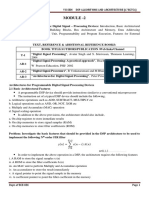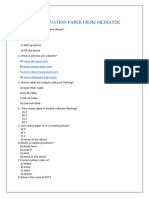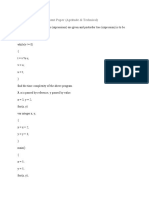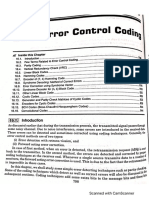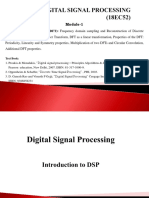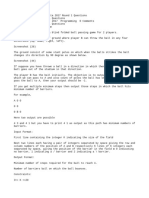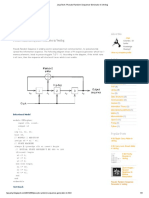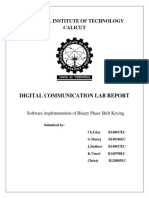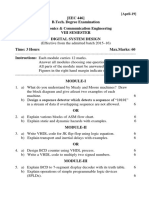D. Y. Patil College of Engineering, Akurdi. Department of Electronics & Telecommunication
Uploaded by
SukanyaD. Y. Patil College of Engineering, Akurdi. Department of Electronics & Telecommunication
Uploaded by
SukanyaDYPOCE, Akurdi
D. Y. Patil College of Engineering, Akurdi.
Department of Electronics & Telecommunication
Name: Sukanya Kale Date: 17/11/2021
Roll No.: TEA110 PRN: 72018160H
Experiment No: 02
Simulation Study of performance of BPSK receiver in presence of noise.
Aim: To write a MATLAB program for Simulation study of performance of BPSK Receiver
in presence of noise.
Software: MATLAB/ OCTAVE
Theory:
In binary phase shift keying (BPSK) phase of the sinusoidal carrier is changed according to
the data bit to be transmitted, the carrier phase is changed between 0° and 180°.It uses two
phases which are separated by 180° and so can also be termed 2-PSK.
For generation of BPSK first the binary data signal (0s and 1s) is converted into a NRZ
signal. The graphical representation of BPSK is as shown in figure 1.
Figure 1
TE E&TC (2019 Pattern) Digital Communication
DYPOCE, Akurdi
Block Diagram:
Transmitter:
Receiver:
TE E&TC (2019 Pattern) Digital Communication
DYPOCE, Akurdi
BPSK Waveform:
Signal Space Representation or Constellation diagram of BPSK:
Signal space representation of signals is a very effective and useful tool in the analysis of
digitally modulated signals. Any set of signals is equivalent to a set of vectors. A set of m
vectors is said to be orthonormal if the vectors are orthogonal and each vector has a unit
norm. With the help of signal space representation it is possible to signals used in
communications can be expressed and visualized graphically.
BPSK Constellation without Noise BPSK Constellation with Noise
TE E&TC (2019 Pattern) Digital Communication
DYPOCE, Akurdi
Algorithm:
1. Generate random input bit pattern.
2. Generate BPSK signal by assigning 0°phase shift to the 0 bit and 180°phase shift to 1
bit.
3. Plot constellation of BPSK signal without noise.
4. Define signal to noise ratio from 0 to 30 dB
5. Calculate sigma value as sqrt(10.0^(-SNR/10.0))
6. Generate noisy BPSK signal using sigma (noise variance)
7. Plot constellation of BPSK signal with noise.
8. To find the number of errors compare the original BPSK signal with the noisy BPSK
signal.
9. Find bit error rate by dividing the number of bits in error by the total number of bits
transmitted.
10. Repeat the process for various values of signal-to-noise ratio.
11. Plot the graph of BER vs SNR.
MATLAB Functions:
MATLAB Program:
clc;
clear all;
close all;
nr_data_bits=10000;
b_data=(randn(1,nr_data_bits))>.5;
b=[b_data];
d=zeros(1,length(b));
for n=1:length(b)
if(b(n)==0)
d(n)=exp(j*2*pi);
end
TE E&TC (2019 Pattern) Digital Communication
DYPOCE, Akurdi
if(b(n)==1)
d(n)=exp(j*pi);
end
end
bpsk=d;
figure(1);
plot(d,'o');
axis([-2 2 -2 2]);
grid on;
xlabel('real');
ylabel('image');
title('BPSK constellation without noise');
SNR=0:30;
BER1=[];
SNR1=[];
for SNR=0:length(SNR);
sigma=sqrt(10.0^(-SNR/10.0));
snbpsk=(real(bpsk)+sigma.*randn(size(bpsk)))+i.*(imag(bpsk)+sigma*randn(size(bpsk)));
figure(2);
plot(snbpsk,'o');
axis([-2 2 -2 2]);
grid on;
xlabel('real');
ylabel('imag');
title('Bpsk constellation with noise');
%receiver
r=snbpsk;
TE E&TC (2019 Pattern) Digital Communication
DYPOCE, Akurdi
bhat=[real(r)<0];
bhat=bhat(:)';
bhat1=bhat;
ne=sum(b~=bhat1);
BER=ne/nr_data_bits;
BER1=[BER1 BER];
SNR1=[SNR1 SNR];
end
figure(3);
semilogy(SNR1,BER1,'-*');
grid on;
xlabel('SNR=Eb/No(db)');
ylabel('BER or SER');
title('Simulation of BER/SER for BPSK with Gray coding');
legend('BER-simulated','SER-simulated');
Screenshots:
1. Editor Widow
TE E&TC (2019 Pattern) Digital Communication
DYPOCE, Akurdi
2. BPSK Constellation without noise
TE E&TC (2019 Pattern) Digital Communication
DYPOCE, Akurdi
3. BPSK Constellation with noise
4. BER Vs SNR plot
TE E&TC (2019 Pattern) Digital Communication
DYPOCE, Akurdi
Conclusion:
In this experiment we studied about performance of BPSK Receiver in presence of noise.
TE E&TC (2019 Pattern) Digital Communication
You might also like
- Example Sky Airtemp Humidity Wind Water Forecast Enjoysport 1 2 3 4No ratings yetExample Sky Airtemp Humidity Wind Water Forecast Enjoysport 1 2 3 46 pages
- Speech PROCESSING NOTES 8TH SEM VTU Module3100% (1)Speech PROCESSING NOTES 8TH SEM VTU Module326 pages
- AL3411 ARTIFICIAL INTELLIGENCE AND MACHINE LEARNING LABORATORY L T P CNo ratings yetAL3411 ARTIFICIAL INTELLIGENCE AND MACHINE LEARNING LABORATORY L T P C11 pages
- Digital Circuits and Signal Simulation Lab Manual-(R23)-1 (1)No ratings yetDigital Circuits and Signal Simulation Lab Manual-(R23)-1 (1)95 pages
- Probability & Random Process Formulas All UnitsNo ratings yetProbability & Random Process Formulas All Units10 pages
- Cadence Placement Paper (Aptitude & Technical)No ratings yetCadence Placement Paper (Aptitude & Technical)7 pages
- Ec 8702 Ad Hoc and Wireless Sensor NetworksNo ratings yetEc 8702 Ad Hoc and Wireless Sensor Networks33 pages
- ITC Unit 3 Linear Block Code and Cyclic CodeNo ratings yetITC Unit 3 Linear Block Code and Cyclic Code35 pages
- Week 4 Coding Assignment Name: Priyanka Indra Roll No.: 84 Dept: CSE Sem: 6No ratings yetWeek 4 Coding Assignment Name: Priyanka Indra Roll No.: 84 Dept: CSE Sem: 611 pages
- BEL_Probationary_Engineer_Electronics_Official_Paper_Held_On_17_Dec_2023_Shift_1__ee6bd2b3e59e1da08a63146b0f7baefaNo ratings yetBEL_Probationary_Engineer_Electronics_Official_Paper_Held_On_17_Dec_2023_Shift_1__ee6bd2b3e59e1da08a63146b0f7baefa43 pages
- Technological Innovation Management and Entrepreneurship: Model Question Paper - With Effect From 2020-21 (CBCS Scheme)No ratings yetTechnological Innovation Management and Entrepreneurship: Model Question Paper - With Effect From 2020-21 (CBCS Scheme)7 pages
- Pseudo Random Sequence Generator in VerilogNo ratings yetPseudo Random Sequence Generator in Verilog3 pages
- 54118-mt - Advanced Digital Signal ProcessingNo ratings yet54118-mt - Advanced Digital Signal Processing2 pages
- National Institute of Technology Calicut: Digital Communication Lab ReportNo ratings yetNational Institute of Technology Calicut: Digital Communication Lab Report9 pages
- When To Use SU24?: Important!!! SAP Security Interview Questions SAP Security-Authorizition100% (1)When To Use SU24?: Important!!! SAP Security Interview Questions SAP Security-Authorizition3 pages
- Pronouns Are Words We Use in The Place of A Full Noun.: Subject ObjectNo ratings yetPronouns Are Words We Use in The Place of A Full Noun.: Subject Object20 pages
- Ensor & Claire (2008) - Content or Connectedness Mother Child Talk and Early Social UnderstandingNo ratings yetEnsor & Claire (2008) - Content or Connectedness Mother Child Talk and Early Social Understanding16 pages
- (OLD) Subject Verb Agreement by Sanjeev Thakur Revision+SheetsNo ratings yet(OLD) Subject Verb Agreement by Sanjeev Thakur Revision+Sheets58 pages
- 05. Lshift4, Program Counter, ALU, Register File and RARSNo ratings yet05. Lshift4, Program Counter, ALU, Register File and RARS17 pages
- Literary Analysis Literary Theory Presentation RubricNo ratings yetLiterary Analysis Literary Theory Presentation Rubric2 pages
- Chapter 1: The Essence of Catholic MoralityNo ratings yetChapter 1: The Essence of Catholic Morality2 pages
- Interaction and Communication in Individuals With Demetia Level 3. Finished0% (1)Interaction and Communication in Individuals With Demetia Level 3. Finished4 pages
- English Beginner Plus - Introduction For Instructors-Points For Teaching English-1No ratings yetEnglish Beginner Plus - Introduction For Instructors-Points For Teaching English-1100 pages








